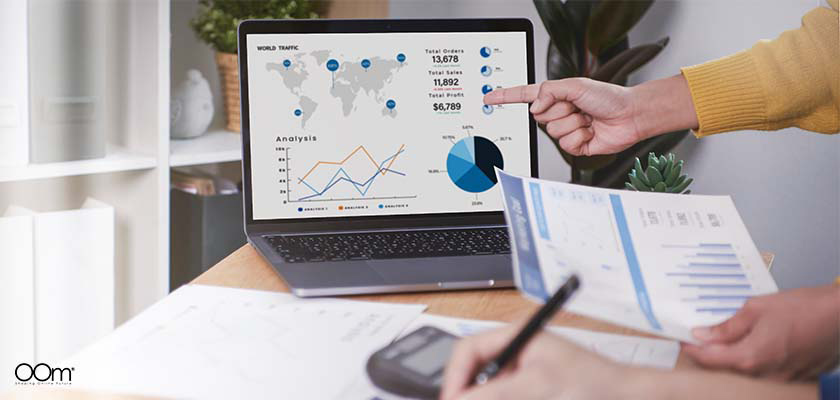How to Make a Buyer Journey Map for Your Brand
Here’s your quick guide to buyer journey mapping — including step-by-step instructions and examples to follow.

A buyer journey map helps brands stand in the shoes of their customers. Following their steps, they head north on Awareness Street toward Consideration Road, turn left and continue for 0.5 miles until Decision Stage is on their right.
Of course, there are quite a few more steps involved than that. Customer journey mapping helps make sense of all the interactions buyers have with a company before and after making a purchase.
The result points companies in the right direction to optimize customer experiences, meet expectations and boost conversions.
We’ll walk you through the basics so you can lead the way in mapping out your buyer journeys.
What is a Buyer Journey Map?
A buyer journey map is a visual representation of a customer’s experience with a company. This includes being introduced to the brand, making a purchase and every customer touchpoint that happens in between.
Even your ideal customer can go through a lengthy buying process that includes multiple opportunities for engagement. To name a few: social media posts, emails, website landing pages, ads, sales one-pagers, support team calls and so on.
Keep in mind that some elements of the customer journey may be beyond your marketing control, such as online reviews or word-of-mouth awareness. Any touchpoint is an interaction that can influence someone’s opinion of your company, product or service.
By detailing what buyers need and want at each stage of their customer experience, buyer journey mapping will push you to consider all possible touchpoints. From there, you’ll develop a deeper understanding of what motivates or inhibits decisions during the buying process.
X Marks the Spot: A Treasure Trove of Buyer Insights
While it would be nice if a customer’s buying process was a straightforward path, there are several steps — and stops — involved that make it a complicated journey. More often, the path is disjointed, cyclical or repetitive. It’s also heavily influenced by changing trends, news cycles and evolving customer needs.
Buyer journey mapping helps businesses make sense of what actually happens before customers make a purchase. This intimate understanding will help you predict customer actions and pinpoint the touchpoints that drive buyers toward the goal of completing a purchase — as well as barriers that could make them turn the other way.
The golden nuggets of insights you’ll gain from buyer journey maps include:
Bird’s-eye view of how customers engage with your company.Buyer emotions and feelings during each stage of their journey.Gaps or pain points in your current customer experience.Differences between buyer personas.Moments that turn leads into loyal customers.Armed with these insights, you’ll be able to create a structured process that ensures you’re taking advantage of all conversion opportunities along the buyer journey. This will help you:
Enhance your customer experiences.Create touchpoints that speak directly to customer pain points.Implement more effective inbound marketing strategies.Align team members on customer-centric approaches.Boost conversion rates.Improve customer retention.The most effective marketing and sales teams have a strong understanding of the audiences they’re reaching. Buyer journey maps are one of the best tools for getting you there.
Subscribe to
The Content Marketer
Get weekly insights, advice and opinions about all things digital marketing.
Thanks for subscribing! Keep an eye out for a Welcome email from us shortly. If you don’t see it come through, check your spam folder and mark the email as “not spam.”
5 Steps to Build Your Own Buyer Journey Maps
Before you start, we recommend preparing some key elements to get the most out of a customer journey map.
Key perspectives: Make sure you bring in stakeholders from multiple departments to address the questions you’ll need to answer and ensure seamless transitions during buyer journeys. Case in point: The hand-off from marketing to sales can make or break a deal.Buyer personas: These descriptions of people in your target audience should include details about demographic information, lifestyle, needs and desires. You’ll need this customer data to map out your customer perspectives on paper.Buying process: Identify the buying stages or phases that are most relevant for your company. A common flow is from awareness to consideration and then the decision stage.Touchpoints: Consider the various ways customers interact with your brand before they buy. You’ll need this list handy when filling out your buyer journey maps.Destination: You can map out the buying process for specific products or services, and even include stages beyond the purchase that focus on delighting and retaining the customer. It helps to have a clear idea of how granular you want to get before your dive into mapping.When you’re ready, follow these steps to map your customer journeys:
1. Set Your Sights On Clear Objectives
Think about what you want your buyer journey map to tell you and why. Which customer experience should it analyze? Who is the map about? Do you want to find out what motivates customers to buy from your company — or identify areas of improvement to boost conversions?
Defining your objectives will give your maps a clear focus and ensure they’re connected to your larger business goals.
2. Get To Know Your Customers On a Personal (and Data-Driven) Level
You’ll need a good understanding of who your customers are before you can visualize their buying process. Both quantitative and qualitative data work here — as long as you narrow your analysis to information that’s relevant to the experience you want to cover in your buyer journey map.
Gather data from the usual suspects, including Google Analytics and your social media accounts. This will help you connect data points like a high-performing landing page or social post to the stage when they encourage users to take an action.
If time allows or gaps in your customer data call for more research, consider sending out surveys or conducting user testing to get feedback from real customers. Helpful questions could include:
How did you hear about our company?What attracted you to our product or service?Did you experience any problems when shopping online?How long did you spend on our website before you made a purchase?Have you interacted directly with anyone on our team? If so, did you communicate with them before or after your purchase?Your colleagues will also be helpful at this stage. Gather feedback from team members in customer-facing roles who can provide unique perspectives on specific stages of the buyer journey. For example, what are the most common questions your sales team hears from prospects?
Customer service chat logs, emails and online reviews offer even more sources of useful information about your audience.
From an empathetic perspective, spend some time thinking like a potential customer to identify some of the emotions and feelings they’re experiencing as they move through the buying process. What questions do they have? What are the happy moments versus the pain points? Will they run into any technology or lifestyle barriers?
All of this data will help you create buyer personas that reflect your prospective customers.
2. Choose Your Buyer Persona(s)
Remember that your map requires focused direction to be effective. There’s only room for one buyer persona on a map, so don’t distract from your goals by grouping too many experiences.
If you’re just dipping your toes into buyer journey mapping, start with your most common buyer persona and focus on their initial engagements with your company. Otherwise, you can target a few buyer personas by creating multiple maps.
3. Match Touchpoints to Actions and Stages
Now it’s time to list out all of the ways your customers can interact with your company. Consider both the digital user journey and physical customer touchpoints.
Your list might include:
WebsitesEmailSocial channelsMobile appOrganic and paid advertisingDigital marketing campaignLive chatOnline surveysEventsVideosPodcastsReviewsPrinted marketing materialsBusiness cardsBrick-and-mortar store locationsProduct packagingThird-party review sites or mentionsOnce you have an exhaustive list, consider the touchpoints that are most likely to encourage action or inspire a feeling. Using your customer data, pair them up accordingly so you start to paint a picture of where the touchpoints fit along the buyer journey.
Don’t forget the roadblocks along the way as well. What might cause a prospect to stop in their tracks or deter them from taking an action? Your map should reflect these obstacles so you know where the opportunities to prevent them exist.
At each stage, you’ll want to consider questions like:
What is the customer thinking or feeling?What is the customer’s action?What does the customer want to know or solve?What is the touchpoint with our company?How can we make the customer move forward to the next stage?Be sure to always focus on the customer. Your map should be an honest portrayal of a customer’s experience through their eyes rather than from your company’s perspective.
4. Map It All Out
Organize all of your thoughts into a spreadsheet or other visualization that captures your buyer journey. Start by breaking the journey into stages and then plug in your customer actions, emotions, touchpoints and any other elements you want to highlight.
If you’re feeling lost, don’t worry! The examples below will be your guides.
5. Take Your Journey Map For a Test Run
When your buyer journey map is finished, take it for a spin to start analyzing the results.
If you notice an area where a pain point might cause a prospect to abandon their journey, you can start brainstorming ways to combat that negative experience. On the flip side, you’ll also be able to identify when your customer personas are happiest and ensure you’re reaching prospects with the right touchpoints.
Moving Forward With Your Buyer Journey Maps
Your buyer journey maps should evolve to reflect changes in your customers and marketing strategy. Think of them as living, breathing resources that need some attention on a monthly or quarterly basis to check for any updates — and ideally spark new inspiration!
Buyer Journey Map Examples
Because a buyer journey map is a visual tool, you’re free to format it however you’d like. A simple Excel spreadsheet can do the trick, though many brands choose to utilize icons, flow charts, color coding and other design elements to visualize their customer journeys.
Your final result might look something like the following examples.
B2B Buyer Journey Map Example

This buyer journey map prioritizes mapping out the goals and touchpoints that accompany each stage. Because many B2B companies offer products or services that require more than a one-time purchase, the map goes beyond the initial buying decision.
These elements make it a useful guide for identifying when various types of content can be most effective and ensuring they’re created with the right objectives in mind.
Retail Buyer Journey Map Example

Along with communicating the specific steps in the process of shopping for a new car, this journey map includes the buyer persona it relates to and a high-level narrative from the customer’s perspective. These added touches are tangible ways to really put yourself in the shoes of Eric, the emotional car buyer.
Omnichannel Buyer Journey Map Example

This detailed map takes a different visual approach that allows for a comparison between touchpoints. It also indicates varying emotions throughout the process, indicating that there are phases on the home remodeling journey that are especially challenging — and therefore an opportunity for touchpoints that ease those pain points.
Once you map out your buyer journeys, it’s time to create, publish and promote the content that will keep your prospects moving from touchpoint to touchpoint. Subscribe to The Content Marketer for weekly insights that will help you master all those elements of the process as well.

 Tfoso
Tfoso 







![B2B & B2C Instagram Marketing Trends of 2022 [Data from 500 Marketers]](https://blog.hubspot.com/hubfs/instagram%20marketing%20trends%202022-1.jpg#keepProtocol)




_1.jpg)



















